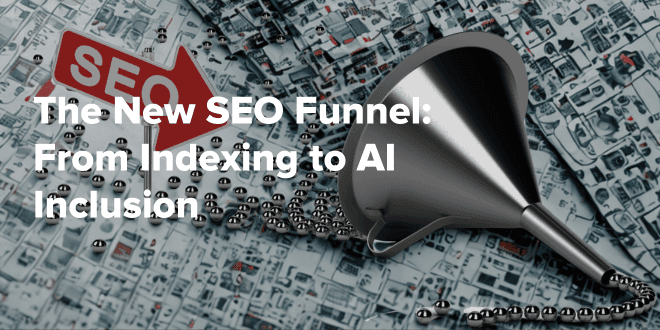
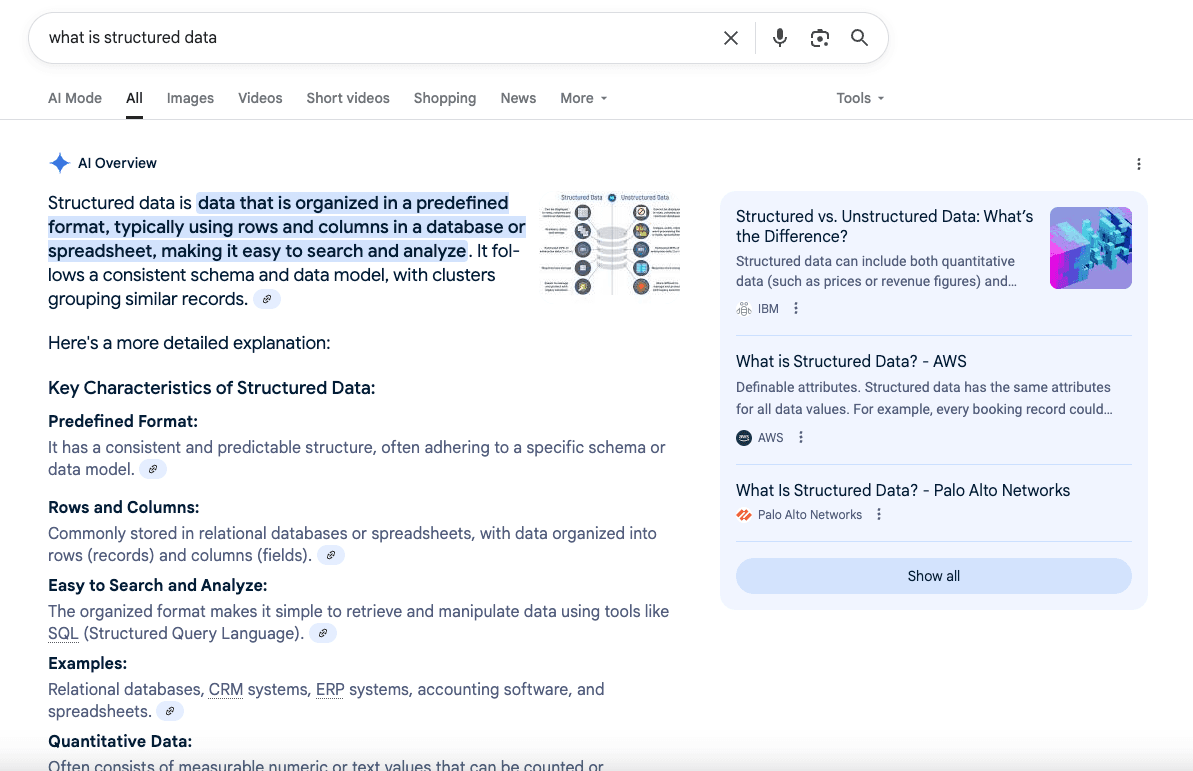 This makes it extremely easy for users to find what they need in the Overview and then click away from Google.
That’s not to mention the growing number of users opting for AI-powered Google alternatives like Perplexity, Claude, and ChatGPT.
While this may seem like the SEO apocalypse, that’s only if you’re tracking old metrics like clicks and rankings.
Evidence shows that people look up brands after discovering them in AI summaries.
For example, Samsung found out that 28% of its branded search traffic came from zero-click search (i.e., AI Overviews and featured snippets). Booking.com also saw a 24% in brand search volume by optimizing for AI visibility.
Translation: Success with search marketing is still possible, you just need new KPIs.
Read on to learn how to adapt to the new SEO funnel!
This makes it extremely easy for users to find what they need in the Overview and then click away from Google.
That’s not to mention the growing number of users opting for AI-powered Google alternatives like Perplexity, Claude, and ChatGPT.
While this may seem like the SEO apocalypse, that’s only if you’re tracking old metrics like clicks and rankings.
Evidence shows that people look up brands after discovering them in AI summaries.
For example, Samsung found out that 28% of its branded search traffic came from zero-click search (i.e., AI Overviews and featured snippets). Booking.com also saw a 24% in brand search volume by optimizing for AI visibility.
Translation: Success with search marketing is still possible, you just need new KPIs.
Read on to learn how to adapt to the new SEO funnel!
What is the AI SEO Funnel?
While generating leads and sales through AI search is vastly different from traditional SEO, the classic sales funnel stages are still present.
In other words, you’re still using content to guide potential customers through every stage of their buyer’s journey.
Optimizing content for this type of sales funnel means:
- Earning more brand mentions online (brand mentions and branded search volume are extremely important for AI visibility).
- Publishing helpful thought leader content that’s written by experts (with detailed author biographies).
- Using proper schema markup (from Schema.org) to ensure LLMs understand your brand, products, and author bios. This aids with NER (named entity recognition).
- Adding entries into trusted data repositories like GitHub to establish authority and credibility.
- Using semantic HTML to aid with LLM understanding (in the same way schema markup does).
| AI SEO funnel | Classic SEO funnel | |
| TOFU (top of the funnel) | AI Overviews, zero-click searches, summaries from tools like ChatGPT – clicks are delayed | Informative blogs ranked in the top 3 organic positions, featured snippets – generates immediate traffic |
| MOFU (middle of the funnel) | Users look up your brand after seeing you appear in LLM search consistently. Structured case studies, price comparisons, and Q&A content. | Buyer’s guides, price comparisons, and reviews (commercial intent keywords) |
| BOFU (bottom of the funnel) | Users either click on a branded search result, fill out a call form, or visit your site directly. | Landing pages, product demos, blog CTAs (all captured through transactional keyword searches) |
Top of the funnel: Introducing audiences to your brand
 At the top of the funnel (TOFU), there’s the awareness stage, which is where you must capture your audience’s attention.
In the AI-dominated search era, this means:
At the top of the funnel (TOFU), there’s the awareness stage, which is where you must capture your audience’s attention.
In the AI-dominated search era, this means:
- Appearing in AI Overviews as a cited source
- Getting mentioned in relevant searches by tools like ChatGPT
- Gaining attention from zero-click searches
- Use eye-grabbing logos
- Publish truly unique content with stand-out headlines
- Use schema markup and semantic HTML
- Earn more brand mentions through digital PR
Middle of the funnel: Convincing prospects that you’re the best
At this point, prospects have become aware of your brand through frequent appearances in AI-generated search snippets. Now, your goal is to convince them that your brand has the solution they’ve been looking for (and that you’re better than the competition). How can you do this with an AI SEO funnel? One of the best ways is to get LLMs to start recommending your brand. For instance, if you’re a professional photographer in Fresno, California, you’d want a tool like ChatGPT to recommend your services to its users for queries like:- Who are the best photographers in Fresno?
- Which photography studios in Fresno take the best wedding pictures?
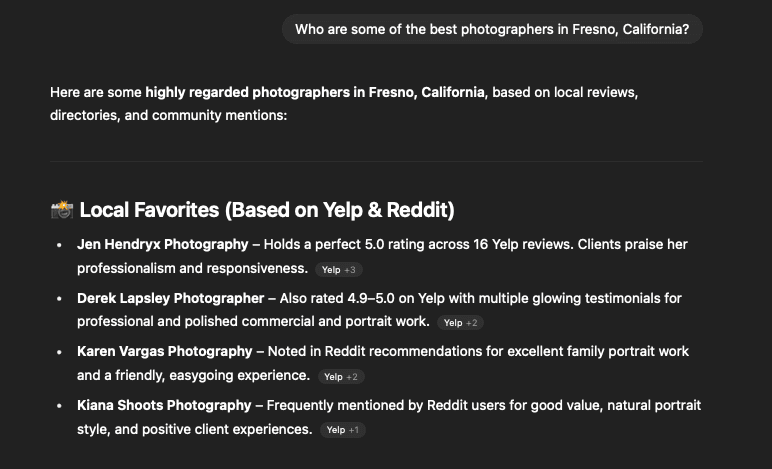 Here, ChatGPT provides us with what it believes to be the highest quality photographers in the area we requested.
Why did it choose these particular photographers?
Going by what it told us, it’s clear that Yelp and Reddit reviews play major roles, but let’s dive a little deeper:
Here, ChatGPT provides us with what it believes to be the highest quality photographers in the area we requested.
Why did it choose these particular photographers?
Going by what it told us, it’s clear that Yelp and Reddit reviews play major roles, but let’s dive a little deeper:
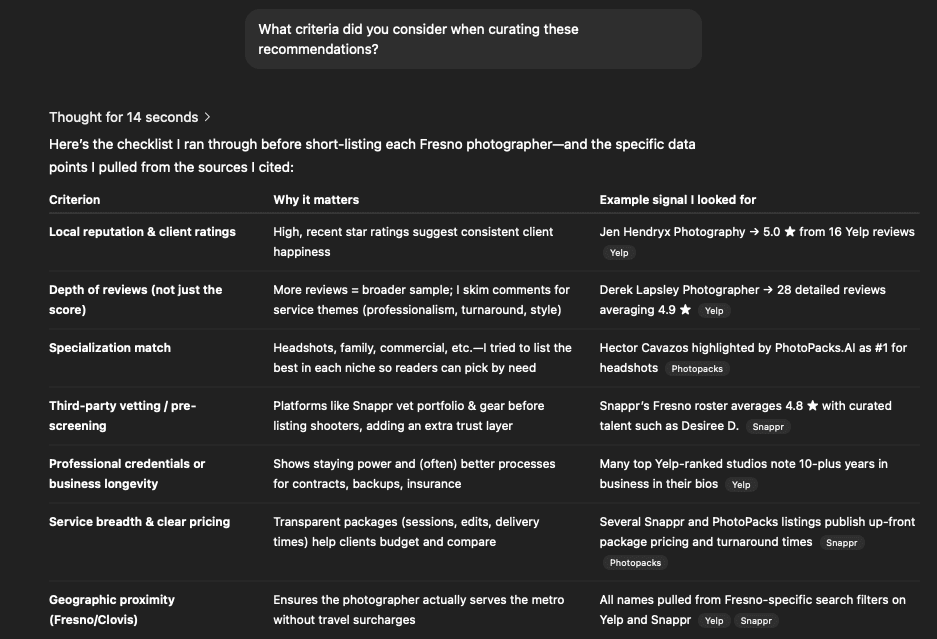 This lets us know that factors like review volume, transparent pricing, and third-party vetting are also extremely important for earning recommendations.
So, if you want to strengthen the middle of your AI SEO funnel, you should:
This lets us know that factors like review volume, transparent pricing, and third-party vetting are also extremely important for earning recommendations.
So, if you want to strengthen the middle of your AI SEO funnel, you should:
- Manage your online reputation and reviews (especially on third-party sites like Yelp, but also your Google Reviews).
- Include schema markup for the reviews on your website (to make them easier to identify).
- Get your products and services listed in credible industry round-up articles.
- Provide transparent pricing models.
- Include your credentials, certifications, and business experience (along with Author schema markup.
| Don’t have time to manage your reviews? Check out our Review and Reputation Management Service! |
Bottom of the funnel: Sealing the deal
The last stage of the funnel represents when a prospect is about to convert into a paying customer. In the AI SEO funnel, this can happen when:- A tool like ChatGPT directly recommends your brand
- A user decides to visit your website after determining that your brand is the best
- A user clicks on a well-placed CTA (call to action) in a FAQ section cited by an AI tool
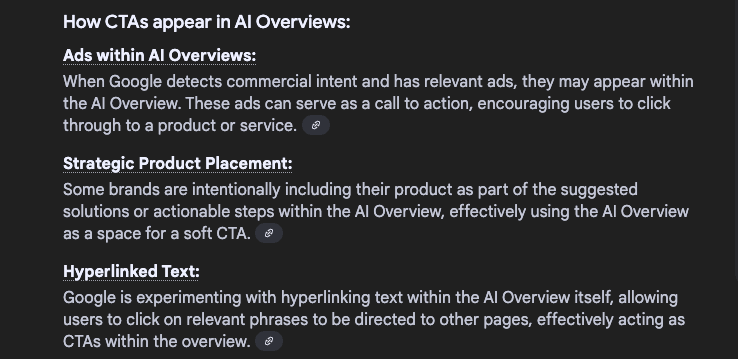 Schema markup matters for your BOFU AI content, too.
Don’t forget to hit landing pages and lead capture pages with schemas like:
Schema markup matters for your BOFU AI content, too.
Don’t forget to hit landing pages and lead capture pages with schemas like:
Which Signals Influence Progress Through the AI SEO Funnel?
Now that you’ve got a grasp of the stages of the funnel, how do you know when users are progressing through them? In classic SEO, you could measure things like click-through rates (CTRs) and organic search rankings. As stated previously, a new set of KPIs is necessary for AI SEO. Here are the metrics you should track for each stage of the funnel.TOFU KPIs
Here are the KPIs you should measure for TOFU visibility:- Your presence in Google’s AI Overviews (you can track with Ahrefs, Semrush, Keyword.com, and a few other tools).
MOFU KPIs
Some middle-of-the-funnel KPIs include:- Branded search volume (Ahrefs, Brand24, etc.)
- Time-on-site for AI referred visits (GA4 average engagement time)
BOFU KPIs
Lastly, here’s what to track at the bottom of the AI SEO funnel:- Lead attribution from AI brand mentions (GA4 paired with a CRM)
- Content-to-conversion rate (i.e., which content pieces drive business by appearing in AI search?)
- Conversion rate from zero-click search exposure (monitor for spikes in branded terms on Google Search Console and monitor behavior post-exposure).
Concluding Thoughts: Why You Need an AI SEO Funnel Strategy
Search isn’t the same as it was just two years ago, and it’s imperative for brands to adapt to the changes. That means developing a strategy for the AI search funnel instead of relying on traditional SEO KPIs (which will leave you blind and confused). Are you not sure how to make the transition? Don’t want to book a free strategy session with us to learn how to thrive in the era of AI-dominated search!The author
Rachel Hernandez
description
Previous
Schema Markup for AI: The Tags That Help You Get Pulled
Next
From Obscure to Known: How to Build an Entity Profile AI Can Find
Discussion
Comments
Anju
October 7th, 2025
Great insights! The article perfectly captures how SEO is evolving in the age of AI. Love the focus on brand authority and entity building, that’s where the future of visibility lies.
Louise Savoie
August 11th, 2025
Interesting take on the evolving SEO funnel. I like how it explains the shift from measuring clicks and rankings to tracking brand mentions, AI visibility, and delayed conversions. Great read, thanks for sharing!
Prabu
August 9th, 2025
Interesting shift — feels like SEO is now less about just getting indexed and more about being ‘chosen’ by AI answers. Curious how this changes keyword strategy.
